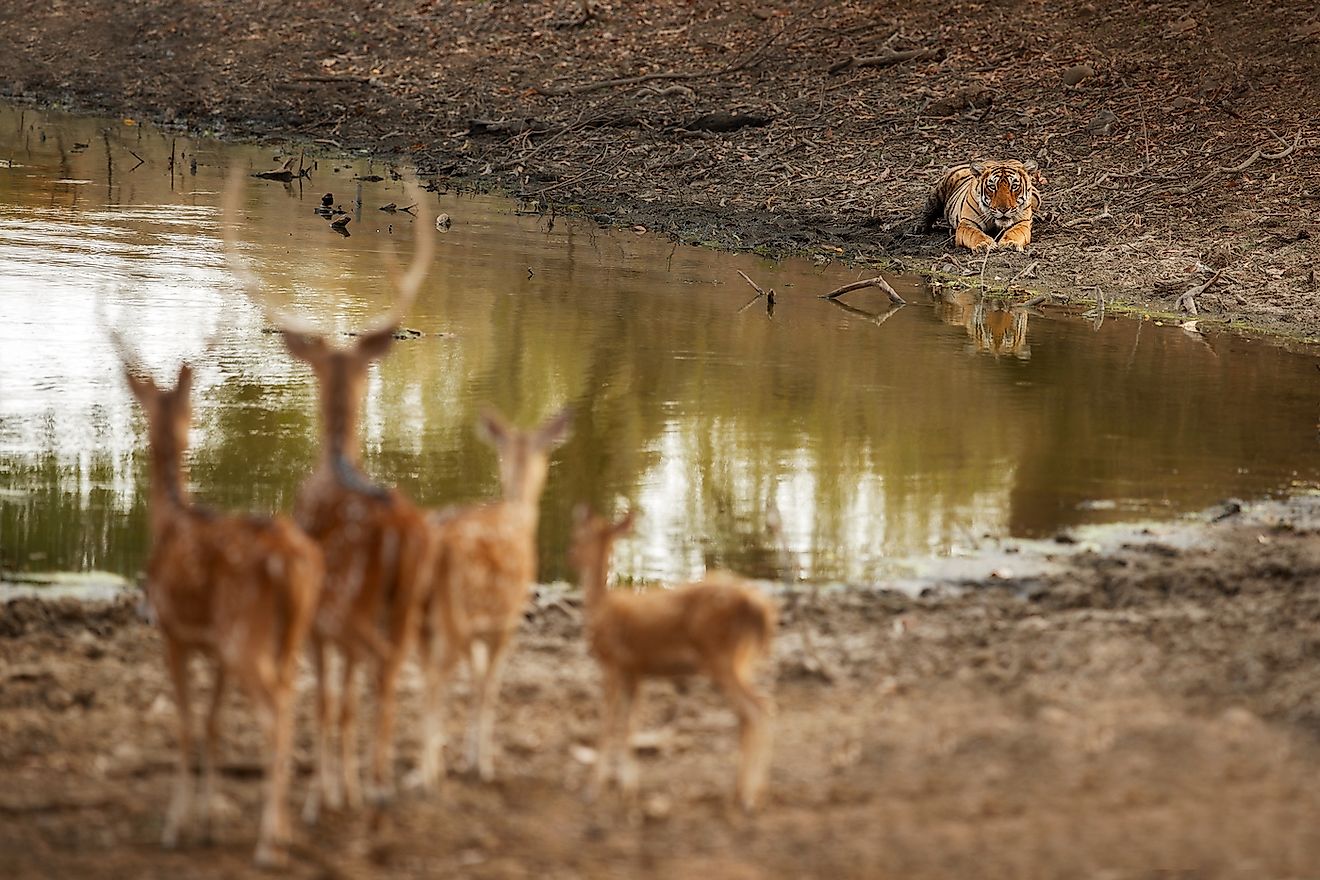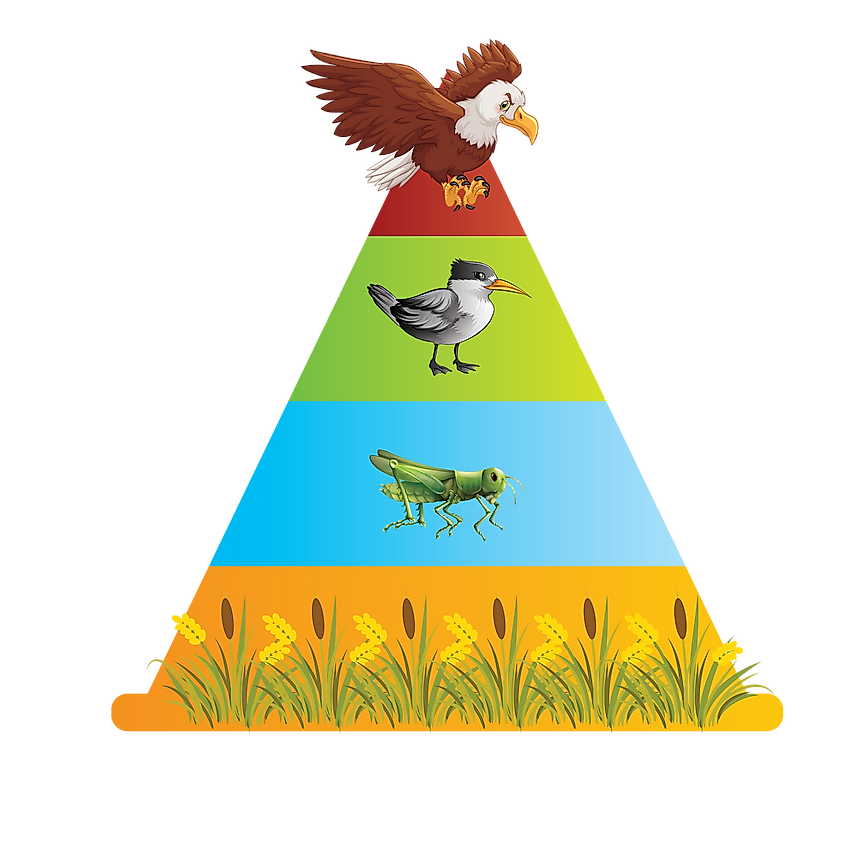What Is An Apex Predator?

- Apex predators sit on top of the food chain and hunt other animals but have no predators that hunt and eat them.
- Apex predators also keep the ecosystem healthy by weeding out the weak and dying animals, thereby increasing the population’s health.
- While apex predators are not hunted and killed by other animals, they are not safe from humans. Many of the world’s top predators are either endangered or have had their populations drop drastically over the years.
In the wild, there is a hierarchical structure called the food chain that determines the order in which living things feed on other organisms. Predators are much higher up on the food chain than prey and rely on other organisms for food. Depending on the predator’s position along the chain, they have very few or no other animals that feed on them. For example, a frog is a predator that eats grasshoppers (the prey) but are preyed upon by hawks, ranking them lower on the chain than hawks. On the other hand, hawks stand at the top of the food chain, making them an apex predator. Many animals are on top of the food chain, such as lions, wolves, and great white sharks.
What Is An Apex Predator?

Apex predators are those that sit on top of the food chain. They hunt other animals but have no predators that hunt and eat them. Usually, apex predators are the largest and most dominant predator within their habitat. Humans have introduced some apex predators. An example is the dingos in Australia, which researchers believe were brought to the country between 3,000 to 4,000 years ago.
Other animals have become the dominant predator in their habitats after humans killed off the ecosystem’s natural apex predators. An example is the coyotes in the US. After settlers killed off wolves, pumas, and mountain lions, which are apex predators, coyotes ran rampant across the land.
Apex Predator Populations

While apex predators are not hunted and killed by other animals, they are not safe from humans. Many of the world’s top predators are either endangered or have had their populations drop drastically over the years. This dramatic change in their numbers is due to humans killing them to protect livestock or other people, hunting them for food, or encroaching on their habitat, resulting in habitat loss.
In Africa, the lion populations are under threat due to killing by guns or spears, poisoning, and habitat loss. Some reports predict that they could disappear from their habitats in 20 years if there’s no intervention to protect them. Many other apex species are already extinct: three tiger subspecies, two wolf species, and one lion subspecies.
In the US, evidence shows that approximately 200,000 wolves once roamed across the country when Europeans first arrived. Today, less than 5,000 wolves remain. Although there have been many conservation efforts spanning years and costing millions of dollars, wolves only live in 5% of their historic range in the US.
Marine apex predators are also vulnerable to human interference. Shark populations have drastically declined as a result of being hunted for their fins. A 2006 study found humans kill over 70 million sharks by finning per year to keep up with shark fin soup demand.
Ecosystems And Apex Predators

Decreasing apex predator populations directly affect the ecosystems in which they live. Apex predators limit the density of their prey by controlling smaller mesopredators such as coyotes and raccoons. When the top predators disappear from an ecosystem, medium-sized predators’ populations rapidly increase in a process called mesopredator release. This phenomenon decreases biodiversity because the sudden spike in mesopredator populations can force quick changes in an ecosystem’s structures. These mesopredators assume new roles and have a more significant influence in the area.
Experts believe that ecosystems are ruled from the top, starting with the apex predators. Researchers have conducted many aquatic experiments that show predator removal causes damage to food chains. According to the trophic cascade theory, predation is essential in limiting an ecosystem’s population size for various species. Trophic cascade occurs when apex predators are either removed or added to an area and dramatically change an ecosystem’s structure.
Perhaps one of the most well-known examples of a trophic cascade is the gray wolf’s extirpation and subsequent reintroduction in Yellowstone National Park. When human interference eradicated wolves from the park, the elk population multiplied rapidly and grazed across the land, killing young brush and trees. Once wolves were reintroduced, they brought the elk population down and allowed trees to grow along stream banks, which encouraged beavers’ return. The wolves’ aggression towards coyotes decreased their population, which may have also affected other animals such as smaller predators and rodents.

Apex predators also keep the ecosystem healthy by weeding out the weak and dying animals, thereby increasing the health of the population. Without apex predators, an ecosystem can become unbalanced. The absence of top predators can make prey over-abundant, resulting in damage to local plants and disease outbreaks. Apex predators keep a herd of prey continuously moving around, preventing these animals from eating an area to the ground.
Examples Of The World’s Apex Predators
Lion

Lions are one of the most well-known apex predators. They mostly live in sub-Saharan Africa, with a small population in India. They live in groups called prides, which have between 10 to 40 members. The lionesses in the prides are responsible for hunting by setting out in groups to chase after the prey. This cooperation is one of the many reasons why lions are feared and fierce predators. Lions use their size, strength, and speed to take down their target and use their long and sharp canines to kill. They can reach speeds of 50 miles per hour. Lions also have excellent night vision that helps them hunt in the dark. Lions are powerful predators that hunt some of the largest prey on earth, such as antelopes, zebras, and buffalo. Unfortunately, lion populations are decreasing as a result of poaching, habitat destruction, and deforestation.
Killer Whale

Killer whales, also known as orcas, are not whales. They are members of the dolphin family. These animals’ teamwork, agility, stamina, size, strength, and intelligence contribute to their reputation as one of the world’s premier apex predators. Killer whales are known to strategize their hunts, which helps them pursue animals five times their size. Killer whales are social and highly intelligent and live in pods made up of approximately 40 individuals. Killer whales use many innovative hunting techniques in their arsenal and have one of the most diverse diets among marine animals. They hunt any aquatic creature, from small fish to other whales. Killer whales have around 45 teeth that are over seven centimeters long and capable of tearing into prey.
Great White Shark

The great white sharks are perhaps one the most feared animals on earth. It is the largest predatory fish and hunts other small fish, turtles, and whales. Great white sharks have a sharp sense of smell and can detect tiny electromagnetic fields produced by animals. They have strong jaws with multiple rows of over 300 razor-sharp, serrated teeth that grow back once it’s lost. Sharks can go through more than 50,000 teeth in their lives. Great white sharks attack their prey with a single, debilitating bite. They then wait for the victim to get weaker before they come back to eat it. Despite being one of the world’s heaviest animals, great white sharks can reach incredible speeds up to 35 miles per hour and launch themselves more than three meters into the air. Their streamlined bodies make them a speedy swimmer.
Gray Wolf

Gray wolves live and hunt in packs, led by an alpha male and female with six to 10 members. Gray wolves have powerful jaws with large canine teeth. They can pursue prey at 37 miles per hour. A wolf attack begins with pack members choosing and chasing a target. Wolves use their incredible sense of smell and sharp nesting abilities to find and track their prey. They test their prey to look for weaknesses, and the alpha wolves lead the chase. Wolves generally prey on animals that are injured, old, or sick. Once their target falls to the ground, the pack surrounds and kills it. These canines hunt large animals such as moose, elk, and caribou and consume smaller animals like beavers and rabbits.
Crocodile

Crocodiles are the world’s largest reptiles, weighing over 1,000 kilograms. Crocodiles are one of the most aggressive and violent animals and hunt all animals, including wild boar, monkeys, and fish. Crocodiles will even resort to cannibalism and attack other crocodiles. Crocodiles are the ultimate lurkers, camouflaged by their environments. They are stealthy and boast long, powerful jaws and teeth. These reptiles hunt their prey by lying in wait in the water. Once their prey approaches, they will strike it and drag it underwater. They then repeatedly spin the prey with exceptional force to tear away flesh and inflict fatal wounds. This technique is known as the death roll. Crocodiles have good night vision and an acute sense of smell, making them one of the world’s most successful apex predators.
Apex Predators Must Be Conserved
Apex predators are at the top of the food chain and have no other animals that eat them for food. These apex predators include lions, killer whales, and great white sharks. Since top predators are strong and skilled hunters, humans fear them and have killed them for various reasons. As a result, many apex predator populations have drastically declined over the years. However, a decreasing apex predator population can drastically alter their ecosystems. Such changes will ultimately affect humans in a negative way in the long run.











